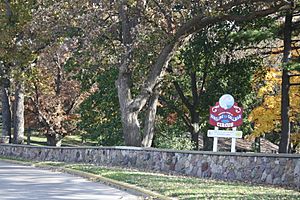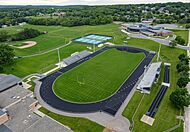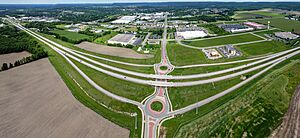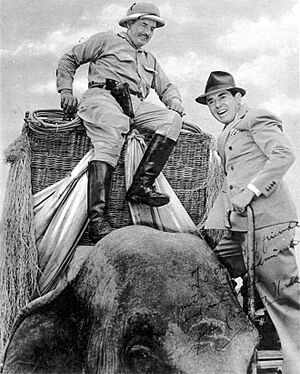Baraboo, Wisconsin facts for kids
Quick facts for kids
Baraboo, Wisconsin
|
|
|---|---|
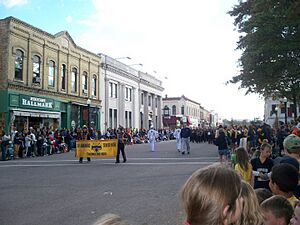
Downtown Baraboo (2010)
|
|
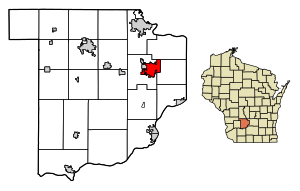
Location of Baraboo in Sauk County, Wisconsin
|
|
| Country | United States |
| State | Wisconsin |
| County | Sauk |
| Incorporated (village) | April 6, 1866 |
| Incorporated (city) | February 25, 1882 |
| Government | |
| • Type | Mayor – Council |
| Area | |
| • City | 7.43 sq mi (19.25 km2) |
| • Land | 7.35 sq mi (19.03 km2) |
| • Water | 0.09 sq mi (0.22 km2) |
| Elevation | 879 ft (268 m) |
| Population
(2020)
|
|
| • City | 12,556 |
| • Density | 1,709.2/sq mi (659.9/km2) |
| • Metro | 55,225 |
| Time zone | UTC−6 (Central) |
| • Summer (DST) | UTC−5 (CDT) |
| ZIP Code |
53913
|
| Area code(s) | 608 |
| GNIS feature ID | 1582749 |
| FIPS code | 55-04625 |
Baraboo is a city in Wisconsin, United States. It is the main city of Sauk County and is located along the Baraboo River. About 12,556 people lived here in 2020.
Baraboo is famous for being the former home of the Ringling Brothers Circus. You can visit the Circus World Museum here. The historic Al. Ringling Theatre is also a popular spot. The city is close to beautiful natural places like Devil's Lake State Park. You can also find Aldo Leopold's famous Shack and Farm nearby.
Contents
History of Baraboo
Early Days
Long ago, around 1665, the Kickapoo had a village in the Baraboo area. The modern town began in 1838 when Abe Wood settled here. It was first called the village of Adams. More settlers arrived in 1839 and built cabins and a saw mill.
In 1846, Baraboo became the main city for Sauk County. This happened after a big competition with the nearby village of Reedsburg. In 1852, the village was renamed "Baraboo" after the nearby river. It officially became a village in 1866 and a city in 1882. By the 1860s, over 2,000 people lived in Baraboo. Many businesses like grocery stores, banks, and hotels opened. In 1872, the Chicago and North Western Railway was built, connecting Baraboo to other places. The city also had many saw mills because it was close to the Baraboo River and Wisconsin River.
Circus City and More
In 1884, the famous Ringling Brothers Circus started in Baraboo. The Ringling brothers had moved to the city in 1875. They performed their first show in 1882. Because of them, many other circuses came to the city. This earned Baraboo the nickname "Circus City."
South of Baraboo, there was once a huge factory called the Badger Ordnance Works. It was the biggest munitions factory in the world during World War II. Later, it was taken down. Now, the land is part of the Sauk Prairie Recreation Area.
The country singer Hank Snow mentioned Baraboo in his 1959 song "I've Been Everywhere." Johnny Cash also famously covered this song.
A company that makes small airplanes, Cirrus, started in a barn near Baraboo in 1984. The Klapmeier brothers founded it. They later moved the company to the Baraboo–Wisconsin Dells Airport. In 1994, they moved to Duluth, Minnesota.
Geography and Nature
Baraboo is about 7.47 square miles in total size. Most of it is land, with a small amount of water. West Baraboo is a town next to Baraboo on its west side.
Baraboo is known for its unique geology. The Baraboo Hills are a special natural area. The Nature Conservancy calls them one of the "Last Great Places." This is because they have rare rocks, plants, and animals. These hills were formed by glaciers. They stand out from the flat land around them.
Devil's Lake State Park is Wisconsin's largest state park. It covers a large part of the Baraboo Hills. Another beautiful spot nearby is Pewits Nest.
Climate
Baraboo has a climate with warm summers. The hottest temperature ever recorded in Baraboo was 103°F (39°C) in July 2012. The coldest temperature was -45°F (-43°C) in January 1951.
People of Baraboo
Baraboo is the main city in the Baraboo Micropolitan Statistical Area. This area includes all of Sauk County. In 2000, about 55,225 people lived in this area.
Population in 2020
In 2020, Baraboo had 12,556 people. Most people were White (88.0%). Other groups included Native American, Black, Asian, and people of two or more races. About 5.9% of the population was Hispanic or Latino.
Population in 2010
In 2010, there were 12,048 people living in Baraboo. About 94.0% of the people were White. Other groups included African American, Native American, and Asian. About 3.7% of the people were Hispanic or Latino.
The average age in the city was 38 years old. About 23.8% of residents were under 18. About 15.6% were 65 or older.
Learning in Baraboo
Baraboo has a campus of the University of Wisconsin–Platteville Baraboo Sauk County. This is a place where older students can go to college.
The School District of Baraboo has several schools for younger students. There are four elementary schools for grades 1-5. There is also a kindergarten center, one middle school, and Baraboo High School. The middle school has a swimming pool that the public can use with a membership.
Baraboo also has three private schools:
- St. Joseph's Catholic School: This school teaches students from Pre-K through sixth grade.
- St. John's Lutheran School: This school teaches students from Pre-K through eighth grade.
- Community Christian School: This school teaches students from 4K through high school.
The Baraboo Public Library serves the community. It's a great place to find books and learn new things.
City Services and Travel
Baraboo has a historic downtown area. It includes 75 buildings built between 1870 and 1938. The Sauk County Courthouse is in the middle of this area. It serves the whole county.
Transportation
The Baraboo-Wisconsin Dells Airport helps people travel to and from the city. It is located north of Baraboo. Several main roads, like State Highways 33, 113, 136, and U.S. 12, pass through Baraboo. You can also get to Interstate 90/94 nearby.
The Wisconsin & Southern Railroad provides freight train service. For passenger trains, the closest Amtrak station is in Wisconsin Dells. Baraboo also has a "Dial-a-ride" service for local travel.
Historic Places to Visit
- The Aldo Leopold Shack and Farm: This place is famous from Aldo Leopold's book A Sand County Almanac.
- The Gust Brothers' Store: A historic building in Baraboo.
- The Walworth D. Porter Duplex Residence: Another historic home in the city.
Famous People from Baraboo
- Donald R. Atkinson: An educator and writer.
- Frank Avery: A Wisconsin State Senator.
- Stan Barnes: A judge for the U.S. Court of Appeals.
- Virgil H. Cady: A Wisconsin State Representative.
- Tiny Cahoon: An NFL football player.
- Jorge A. Carow: A Wisconsin State Representative.
- Ella D. Crawford: An organizer for the temperance movement.
- John V. Diener: A mayor of Green Bay, Wisconsin.
- Evan Alfred Evans: A judge of the U.S. Court of Appeals.
- Evan Glodell: A film director, producer, writer, and actor.
- Elna Jane Hilliard Grahn: An educator.
- Henry C. Hansbrough: A U.S. Senator from North Dakota.
- John R. Hofstatter: A Wisconsin State Representative.
- Guy E. Holmes: A musician and composer.
- John J. Jenkins: A U.S. Representative.
- Robert J. Keller: A Wisconsin State Representative.
- Alan and Dale Klapmeier: The brothers who started Cirrus Aircraft.
- Len Koenecke: An MLB baseball player.
- Belle Case La Follette: A lawyer and activist.
- Nancy Lange: The former First Lady of Peru.
- Louise M. Lawson: A president of the Wisconsin State Woman's Christian Temperance Union.
- Aldo Leopold: A famous naturalist and writer.
- Daryl Morey: A basketball executive for the Philadelphia 76ers.
- Mary Mortimer: A British-born American educator.
- Beryl Newman: A Medal of Honor recipient.
- John Ringling North: The president of the Ringling Bros. and Barnum & Bailey Circus.
- Stuart Palmer: A mystery novelist.
- Delando Pratt: A Wisconsin State Representative.
- Mike Reinfeldt: An NFL football player and executive.
- Cyrus Remington: A Wisconsin State Representative and judge.
- Bradbury Robinson: He grew up in Baraboo and threw the first forward pass in football history.
- Algie Martin Simons: A socialist newspaper editor who went to high school in Baraboo.
- Terry Stieve: An NFL football player.
- Walter Terry: A Wisconsin legislator.
- John M. True: A Wisconsin legislator.
- C. F. Viebahn: A Wisconsin State Representative.
- David Vittum: A Wisconsin State Senator.
- Lewis N. Wood: A Wisconsin State Representative.
- Edwin E. Woodman: A Wisconsin State Senator.
See also
 In Spanish: Baraboo (Wisconsin) para niños
In Spanish: Baraboo (Wisconsin) para niños


